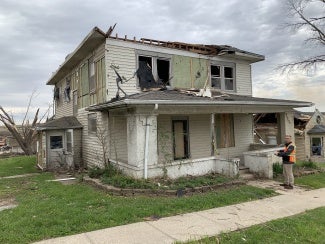
How Iowa architects are aiding tornado relief efforts
In Iowa, architects help disaster victims get back in their homes faster.
Architects work every day to design built environments that are resilient.
We always strive to design for disaster preparedness, but many cities and towns are often not equipped or have not been adapted to withstand the natural disasters we see today — fire, high winds, flooding, earthquakes, and whatever else Mother Nature draws up. Beyond designing for resiliency for the future, architects also need to assist our communities immediately following such events. That is where the Disaster Assistance Program, shepherded by local AIA chapters throughout the country, has allowed architects and engineers to help during these critical moments post-natural disaster.
In Iowa specifically, the AIA Iowa chapter has developed a Disaster Assistance Program, working closely with the State Emergency Management Department through a Memorandum of Understanding (MOU) and continued relationship-building between the state agency and the architecture community.
Iowa, like much of middle America, has vibrant small-town communities scattered across the state that formed pre-automobile. This has led to many communities with only hundreds or several thousand residents, often with small municipal resources. What we have observed recently is that smaller communities do not have the resources to support certain recovery efforts post-disaster. This is where our AIA chapter has helped filled the void, most recently in Minden following a tornado and flooding in northwest Iowa.

A tornado with a rating of 3 on the Enhanced Fujita Scale swept through the town of Minden, approximate population 600, on April 26, 2024. The town did not have staff with building inspection capabilities, so the state mobilized our group as a specialty team to assist in Safety Assessment Program (SAP) evaluations. This effort provided residents with safety assurances to start re-entering their homes and to help restart the community rebuilding efforts. The team evaluated 126 structures, including single family homes, multi-family homes, and commercial buildings. Our group of five architects from across the state helped to identify the critical areas of focus for rebuilding efforts once initial debris was cleared and critical infrastructure was restored.
The AIA Iowa team has worked over the past several years to develop a relationship with the state as a partner in times of need, and we have demonstrated how architects can help lead in post-disaster recovery efforts. This work reinforces the notion that architects are vital in the immediate response just as much as in the recovery and preparedness efforts. No region of the country is short of natural disasters, and it is our responsibility as architects to expand our efforts in disaster assistance, particularly for our country’s smaller communities that may lack the resources for effective disaster response. Architects need to be a critical driver in immediate response and recovery efforts.
Jason Kruse, AIA, is an associate principal in BNIM's Des Moines, Iowa office and a disaster recovery volunteer.


